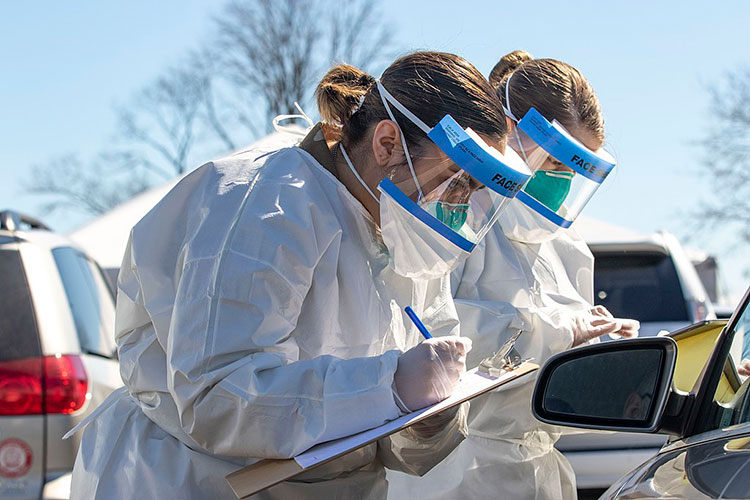COVID-19 has already cost California insurers $2.4 billion, new study estimates
Without a vaccine, costs could likely exceed $25.1 billion, as virus spreads through the state
June 25, 2020

California insurers are bearing billions of dollars of unexpected costs for COVID-19 testing and treatment. (The National Guard photo accessed via Flickr)
The COVID-19 pandemic has cost California’s public and private insurers an estimated $2.4 billion dollars in testing and treatment — about six times the annual cost to treat seasonal influenza in the state, according to a new study by researchers at the Nicholas C. Petris Center at the University of California, Berkeley, School of Public Health.
In the absence of a vaccine, this number could grow to $25.1 billion before enough of the population becomes infected to achieve herd immunity, the study found. The $25.1 billion estimate represents about 6% of the total annual health care spending in California.
The majority of the costs — about 59% — are born by commercial insurers who could pass the sudden expenditure onto consumers in the form of price hikes on health insurance premiums. The rest of the costs are split among the federally-run Medicare program, the state-run Medi-Cal program and uninsured individuals.
“These are unexpected costs to the health care system in California,” said Richard Scheffler, Professor of the Graduate School at UC Berkeley and leader of the research team. “With the budget crisis we’re having, and all the disruption in health care, we now have additional costs that the state has to pay through its Medi-Cal program.”
To calculate the $2.4 billion figure, the team assumed that approximately 5% of individuals in the state have been infected with the virus, and that herd immunity won’t occur until 60% or more of the population has contracted the virus. The study breaks down the costs per capita by county and by insurance payer type.
These numbers are likely underestimates of the future costs of the COVID-19 pandemic to state insurers, the team stresses. They only account for the costs for testing and treatment of acute COVID-19 infections and do not consider the costs of possible long-term complications of the virus, or the costs accrued by patients with other conditions who may be delaying care because of the pandemic.
“Just in the last two months, we’ve recognized a whole slew of chronic diseases that infection with SARS-CoV-2 is causing, including multi-system inflammatory syndrome (MIS-C) that children are getting and heart damage from COVID,” said John Swartzberg, a clinical professor emeritus of infectious diseases and vaccinology at UC Berkeley. “And the list just keeps growing. In two months, we’ve recognized at least five new diseases caused by COVID(-19). And who knows how many more we’re going to see in the next several months to a year or more?”
The team plans to regularly update the cost model as additional data about COVID-19 infections, treatment and costs become available.
A distribution of costs across the state
Using current COVID-19 infection rate and hospitalization data, the team broke down the estimated costs by county, finding wide variation across the state. Bay Area counties like Marin and San Mateo bore some of the highest costs per capita, while Merced and Tulare counties bore some of the lowest.
These discrepancies are likely due to a variety of factors, including differences in health care prices and payer mix, said Daniel Arnold, research director of the Petris Center.
“In previous work, we’ve looked at the difference in commercial prices between Northern and Southern California, and there’s a big difference there, with Northern California prices being significantly higher,” Arnold said. “There’s also a big difference across the state in terms of the portion of each county that’s on Medi-Cal.”
Because seniors are the most likely to be hospitalized for COVID-19, the cost to Medicare of hospitalizations with ventilators was $294 million. The price of these hospitalizations varied widely by insurer — from a low of $53,004 for Medi-Cal/Children’s Health Insurance Program (CHIP) to $57,882 for Medicare and all the way up to $108,898 for commercial.
“We know that people who are older and people with more comorbid conditions face many more severe complications related to COVID(-19), so they could end up in the hospital or in the ICU needing more intensive treatment,” said Brent Fulton, associate adjunct professor of health economics and policy at UC Berkeley and associate director of the Petris Center. “But if a younger person ends up in the hospital under a commercial insurer, that insurer is paying much more than what Medicare and Medi-Cal would pay for that same hospitalization.”
Approximately 59% of the estimated costs were related to hospitalization, while the remaining 41% is split between the costs of testing and office visits.
The team hopes the results of the analysis will help policymakers make more informed decisions about health care coverage in the face of the pandemic.
“It’s not all about dollars. This is about the treatment of people and their lives and deaths,” Scheffler said. “But if you don’t have the money to pay for it, it basically makes things worse.”
RELATED INFORMATION